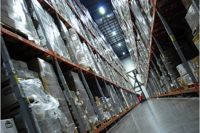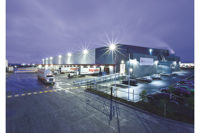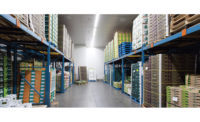Zero Mountain Cold Storage Warehouse, Fort Smith, Ark., boasts four state-of-the-art facilities in the heart of Arkansas. Aiming to reduce energy consumption and eliminate ongoing, costly lighting maintenance, the company upgraded two of its facilities to next-generation LED lighting by Dialight, Farmingdale, N.J. As a result, Zero Mountain has slashed energy consumption by more than 1 million kWh a year and saved nearly $100,000 annually, while bringing its lighting maintenance demand and cost to zero. That’s because Dialight’s ultra-high-efficiency solution outperforms metal halide technology in the harsh environment.
Installation snapshot
- Two cold storage facilities, one a former limestone mine.
- 571 existing metal halides replaced by 456 Dialight LED high bays.
- 21% reduction in fixture count.
- 1.3 million kWh saved annually.
- Nearly $100,000 in annual energy and maintenance savings.
Zero Mountain, a service-focused organization, is dedicated to offering a reliable and responsive cold storage solution to food producers around the country and around the world. At current capacity, the company freezes, stores and ships roughly 2 billion pounds of frozen food and meat annually for numerous Fortune 500 companies.
Its flagship Johnson Underground facility, “The Cave,” located in Johnson, Ark., is a former limestone mine that now boasts 280,000 square feet of refrigerated and freezer space with temperatures reaching in excess of -36°F. Down the road is the Lowell Warehouse in Lowell, Ark., a 7 million-cubic-foot behemoth with cold storage and blast freeze capabilities and the most advanced computerized systems for inventory management and distribution.
The cold, hard truth about metal halide
Both facilities relied on antiquated 400W metal halide (MH) fixtures—268 in The Cave and 303 at Lowell—that were becoming costly to operate and maintain. In addition to the excessive energy used, the lamps demanded near-constant replacement, with changeout required when fixture output dropped below 6 footcandles, rendering this tedious work a routine, monthly chore. Facility managers conservatively estimated maintenance costs to be $5,000-10,000 per year in manpower alone, not including the cost of the actual replacement lamps/ ballasts or any specialized equipment needed (a man lift or bucket truck).
In addition to the drain on resources, the harsh environment proved to be too much for the MH fixtures to handle. Because of their slow warmup time, made worse by the cold temperatures, the company was forced to keep the lights on 24/7. Not only were they lighting space that didn’t need to be lit 24/7, paying more for the electricity and exhausting lamp life faster as a result, but the excessive heat output from the MH lamps also forced the company’s cooling condensers to work even harder to keep the space at optimal temperature. At the Johnson Underground facility, moisture was also a major issue, as the cold temperatures and frost would build up, combined with significant groundwater penetration that would often seep in through the ceiling, especially after a significant rainfall.
The Dialight difference
Looking to make an upgrade, Zero Mountain invited LED Supply Co., a Lakewood, Colo., distributor of Dialight LED products, to demonstrate the benefits of the Dialight LED high-bay solution. The Dialight product offered numerous potential advantages, including:
- a significant energy savings of up to 70%,
- long-life performance that would eliminate lighting maintenance for up to a decade,
- improved on-the-ground footcandle output and extended lumen maintenance,
- the opportunity to reduce the number of fixtures needed to light the same space,
- a more durable solution that would outlast and outperform MH fixtures in the cold, damp and sometimes downright wet conditions, especially in the underground storage facility,
- the ability to add occupancy sensors, eliminating the need to keep the lights on 24/7 in areas of the facility that do not see regular traffic, particularly in the deep freeze section.
At the Johnson Underground facility, the company replaced all 268 MH fixtures with new 150W Dialight LED high-bays in a 1:1 replacement. At Lowell, 303 MH fixtures were replaced by just 188 Dialight 150W LED high-bays for a 21% reduction in the total number of fixtures needed to light the same space. Changeout took just 15-30 minutes per fixture, using existing wiring and mounting hardware.
“Our crews were impressed by how quick and easy it was to change out each fixture, and they’re looking forward to not having to change lightbulbs all the time,” says Tony Parrish, facility manager at Johnson Underground. “This will definitely free up their time to perform more critical maintenance needs that contribute to efficient facility operation.”
$100K saved—and growing
Between the immediate energy and maintenance savings, Zero Mountain has cut its total energy use by more than 1.3 million kWh and saved nearly $100,000 per year. In “The Cave” underground storage, the changeout netted an immediate 71.2 kW reduction in real-time energy use, slashing annual energy consumption by 506,730 kWh for a total savings of nearly $33,000. The results have been even more dramatic at Lowell, where the retrofit immediately lowered energy consumption by 114.31 kW, reducing total annual consumption by 814,569 kWh for nearly $53,000 energy savings per year.
And, the savings will continue to grow. The addition of occupancy sensors is expected to reduce total energy consumption by an additional 30-40%, plus it’s added an unexpected, but most-welcome safety feature.
“The forklift drivers like the sensors because, as the lights come on, it gives them a heads-up that other operators are in the area,” says Tony Nichols, facility manager at the Lowell Warehouse. “It’s like advanced warning system that’s turned out to be a significant advantage when working in tight quarters where visibility is limited.”
In addition to the direct energy and maintenance savings from the lights, both facilities also noticed an immediate impact on the performance of their cooling compressors, which do not have to work as hard now to compensate for the high heat output of the old metal halides. And, at both “The Cave” and the Lowell Warehouse, light levels improved by nearly 100% to 18-20 fcs on average, for greater visibility and a clean, crisp, clear white light that’s easier on the eyes.
Adding to the total ROI, Zero Mountain’s utility provider, Southwestern Electric Power Co. (SWEPCO), Columbus, Ohio, offered a custom rebate incentive for making the switch to LED lighting based on the substantial kWh savings, which offset approximately 30% of the total project costs, including installation.
Zero Mountain management has been so pleased with the overall performance and savings generated by retrofitting just two facilities, the company has already given the green light to upgrade its remaining Fort Smith, Ark., and Russellville, Ark., cold storage facilities.









